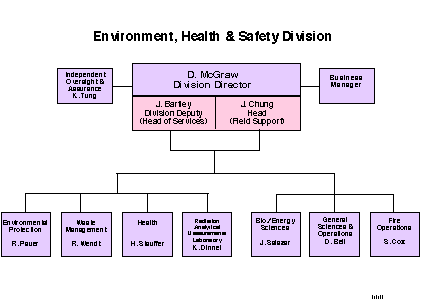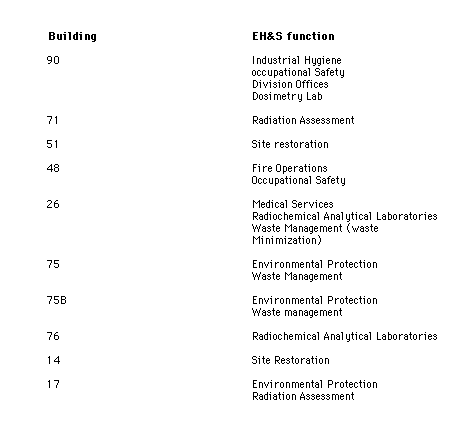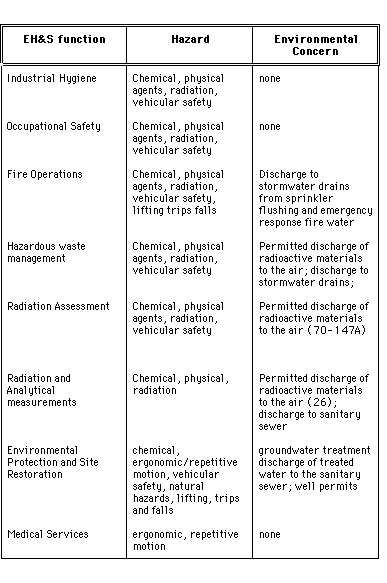
The EH&S Division is organized into departments and groups to align closely with Laboratory organizational structure. There are two departments, each representing a major service functions:Field Support and Services. Reporting to these departments are seven groups. A division administrator, matrixed to EH&S from the Office of the Associate Laboratory Director, Administration, is charged with overall fiscal and personnel management within the Division.
Reporting to the division director, each department head has leadership responsibility for a major functional unit, including three or four subordinate group leaders, plus professionals and technical staff, varying in number from 30 to 50 individuals. Each department head is responsible for management of the department, including planning, staffing, and budgeting, and for the development and implementation of Laboratory policies and procedures in their functional area. Each department head represents the department in contacts with internal and external organizations and individuals on matters of major significance to the success of Laboratory programs and activities. The department head directs the work of subordinate managers in the groups within the department.
Reporting to the division director or a department head, each group leader has supervisory responsibility for an EH&S technical or professional section, project, or function. An EH&S group comprises several professionals and/or technical experts (typically 10 to 25 people), organized to achieve goals in a specific, focused EH&S specialty area.
David Mc Graw is the LBNL EH&S division director. He is responsible for the day to day operations that articulate Lab policies on protection of the public, and the environment, and eliminate potential compliance exposures to the lab. The EH&S divisional Charter provides a roadmap for the rest of the division and is found in the Division Function Notebook.
The division organizational structure is shown below.

At the Berkeley Laboratory the following documents establish the policy and provide the implementation guidance that makes line management is effectively accountable for protection of workers, the public and the environment:
Operations Assurance Plan (OAP) - 1996
Self Assessment Manual - 1992
Supplement - 1996
Publication 3000 - Environment Health and Safety Manual - 1995
Chemical Hygiene and Safety Plan - 1992
Waste Generator Guidelines - 1996
Employee Performance/Progress Review (Section III) - 1996
2) Clear Roles and Responsibilities.
Each Division making up the Berkeley Laboratory has clearly defined lines of responsibility down to the working level. Each division designates a research investigator to represent its views and concerns on the Laboratory Safety Review Committee and a full time employee to act as the ES & H Coordinator. This Coordinator acts as the interface between ES & H concerns and compliance in the workplace and the EH & S technical professionals. The organizational information is updated every 60 days and is retained in the Functional/Facility Notebooks as appropriate (see OAP).
3) Competence Commensurate with Responsibilities.
Job assignments, including hires, are reviewed by line management and by the compensation group within Human Resources to ensure that the requirements and responsibilities of a job are matched by the experience, knowledge and skills of individuals selected for assignment. A performance expectation for managers and supervisors in the Division of Environment, Health and Safety is how well the talents, knowledge and skills of staff are matched to work assignments and responsibilities
The Laboratory's training program ensures that each staff member, including participating guests, is adequately trained to do participate safely in Laboratory activities. Staff, with supervisor participation, fill out the Jobs Hazards Questionnaire (JHQ) describing the hazards associated with their job assignment and work area. Evaluation of the responses by the Training Coordinator and the cognizant supervisor determines the training regimen needed to carry out work in a manner that protects the employee, co-workers, the public and the environment.
4) Balanced Priorities.
All environment, safety and health activities in the Laboratory are described in technical terms with budgetary information included. Each year this information is updated, reviewed and prioritized on the basis of risk to workers, public, and the environment by a Laboratory wide committee selected to represent programmatic line management and ES & H professionals. This document is utilized by Laboratory Senior Management in strategically planning the immediate focus and long term goals of the environment, safety and health program at the Laboratory.
5) Hazard Controls Tailored to Work Being Performed.
Chapter 6 of the Environment, Health and Safety Manual clearly defines the steps for each line manager to develop the appropriate engineering and administrative controls to mitigate hazards in the workplace. The Laboratory's Self Assessment Program, including Functional Appraisals by ES & H professionals, and the UC/DOE Contract 98 Performance Measures provide assurance that implementation of hazards control is adequate to protection the worker, the public and the environment.
6) Identification of Safety Standards and Requirements.
The Laboratory is dedicated to following the Necessary and Sufficient Closure Process (DOE 450.3) on an iterative basis at all levels of activities in the Laboratory to ensure the Safety Standards are adequate to provide protection to workers, the public and the environment. This process is completed by to commencement of work in those situations where current work is significantly modified, new work is proposed or substantial facility modifications are being made (Chapter 6, Environment Health and Safety Manual).
7) Operations Authorization.
Conditions and requirements for facilities determined to be of higher risk based on the Preliminary Hazards Analysis are contained in a Safety Analysis Document. Activity Hazard Documents are the basis for meeting this requirement for specific operations and activities falling into the higher risk category at the Berkeley Laboratory. Internal Agreements describing the performance expectations by each party are used for operations between two functional areas where the quality of performance might adversely impact the Laboratory's ability to meet its responsibility to protect workers, the public and the environment.
EH&S division personnel occupy offices in the following buildings:
 Field
Support Department personnel and select Services Department personnel may
conduct their business in any onsite or Lab operated offsite location. For
instance Fire Operations personnel will respond to emergencies in any location
(as defined above) which may include confined spaces, roofs, radiation areas,
areas where there are hazardous materials and so on.
Field
Support Department personnel and select Services Department personnel may
conduct their business in any onsite or Lab operated offsite location. For
instance Fire Operations personnel will respond to emergencies in any location
(as defined above) which may include confined spaces, roofs, radiation areas,
areas where there are hazardous materials and so on.

Uncertainties about the work
Uncertainties center around future overhead and programmatic funding security.Other uncertainties are focused on the outcome of the Necessary and Sufficient process
The hazardous waste management facility operates under a RCRA Part B Permit. There are public concerns around current and proposed Hazardous Waste Management practices. These concerns are being addressed in cooperation with the California Department of Toxic Substances Control, the permitting agency, as part of a permit modification. The permit modification seeks to change the amount of waste storage and waste treatment options and other minor administrative items.
The National Tritium Labeling Facility is located within the Lab. This NIH funded facility releases tritium (as HTO) through a continuously monitored stack. Environmental samples taken from local streams have revealed the presence of very low levels of tritium. Local public concern has been raised over the presence of tritium in these streams. The Environmental Group meets with the City of Berkeley and participates in public forums to address these public concerns.
As part of a realignment of the Lab fire operations the mutual aid agreement with the City of Berkeley was temporarily suspended. Public concern was raised over the removal of lab fire suppression support. The mutual aid agreement is currently being renegotiated.